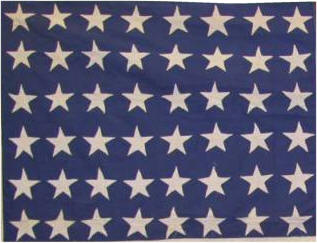 |
Even Rows.
This early 48 star flag
dates to the beginning of
the 20th century, and is
especially rare because of
the beautiful hand
embroidering that reads
"Nov. 11 1918." The
homemade flag celebrates
Armistice Day, also known as
Remembrance Day and today
celebrated as Veteran's Day.
The even rows of 48 stars
were legislated by executive
order of President Taft in
1912.
|
 |
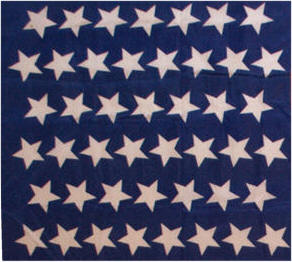 |
Staggered Rows.
The rows on this silk 45
star flag are staggered, as
was commonly done on odd
star counts. Note the
stars which tilt to 1
o'clock in the 7-star rows
(rows 1, 3 and 5) and to the
11 o'clock in the 8-star
rows (rows 2, 4 and 6).
This particular silk flag
has a beautiful overprint in
block painted gilt letters
that reads "In Memoriam POST
185, G.A.R. LOWELL, MASS."
It is a funeral flag made
for a Civil War veteran by
the Grand Army of the
Republic, the Union Army's
fraternal organization. |
 |
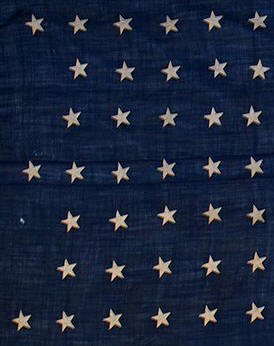 |
Notched Rows.
In times where states were
being rapidly added to the
Union, flag makers sometimes
produced flags in a notched
configuration, leaving room
for the addition of stars
over the life of the flag.
This flag of 38 stars, from
the era of the plains
expansion, North West
territories and the Indian
Wars, features a notched
configuration. The
flag is the size, shape and
style of a Union Infantry
Regimental Battle Flag, and
most likely served that
purpose between 1877 and
1890. |
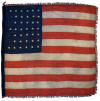 |
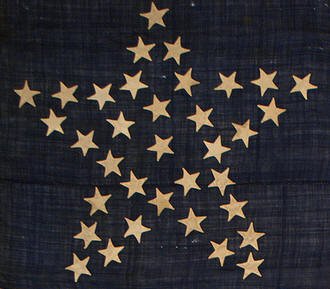 |
Great Star or Grand
Luminary.
This classic Civil War Grand
Luminary Flag was produced
at the height of the Civil
War and is a great
reaffirmation of the Union
that Americans were fighting
to preserve.
Constructed of sewn cotton
stars on wool bunting, the
flag's colors remain rich
and vivid today. |
 |
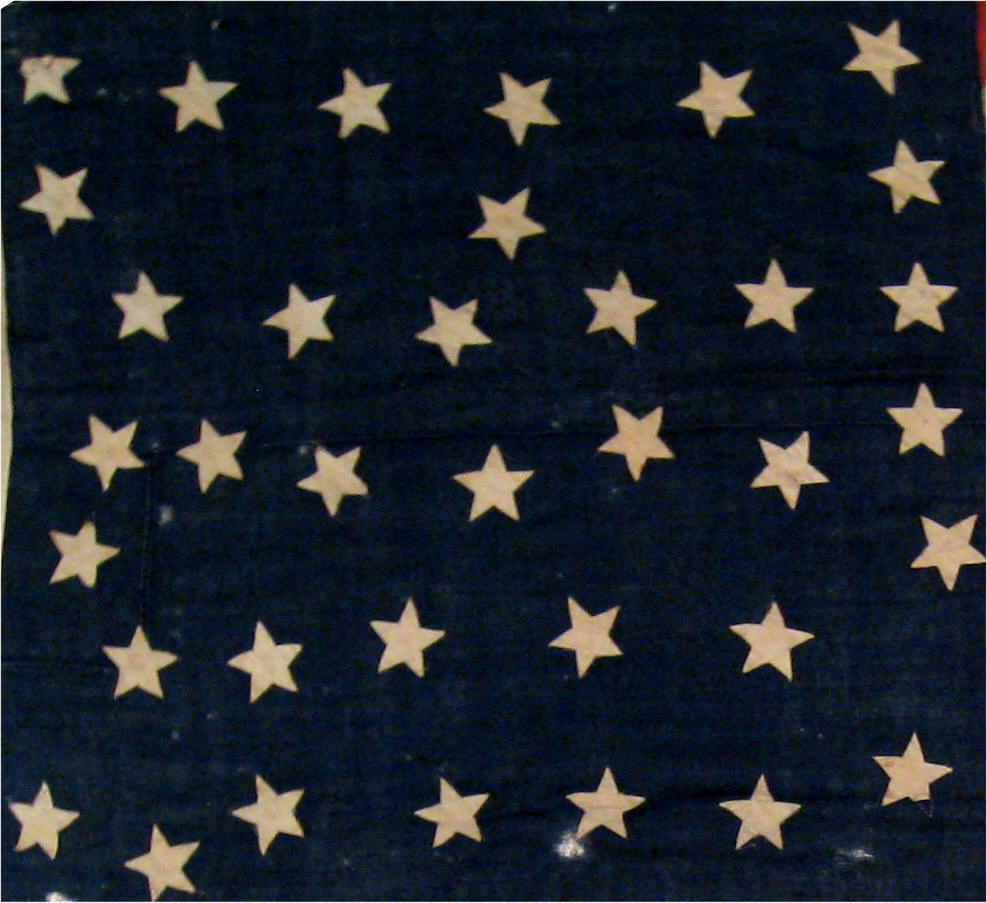 |
Random. The
stars on this 36 star flag
of the Civil War era seem at
first to be in rows, but the randomness of
their placements leads to no
real discernibly consistent
pattern. Here is
another great example of
a flag with a random pattern
of stars. |
 |
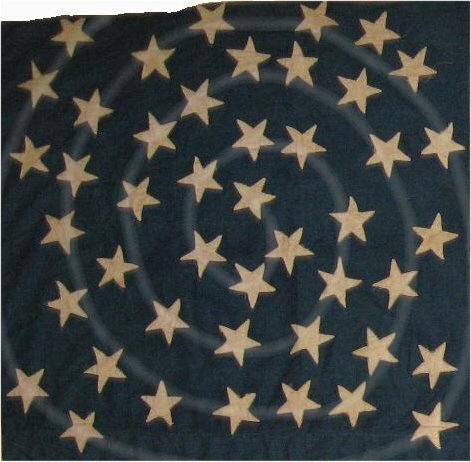 |
Spiral. This
beautiful canton on a 45
star flag appears random but
in fact is in a well defined
spiral pattern, which starts
at the center "key" star.
Without locating the key
star and seeing the first
correct move to begin the
spiral, the stars appear
random. |
 |
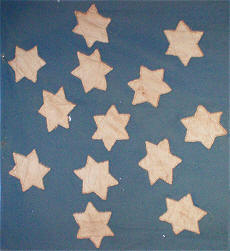 |
Snowflake. One
of the rarest of all
patterns, this pattern
resembles a "snowflake" with
its six arms. The
pattern is known on a very
rare few printed parade
flags of the Civil War era,
and only one known sewn
flag, within the Rare Flags
collection here. |
 |
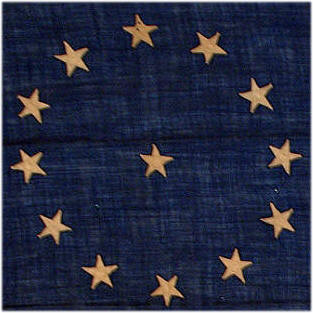 |
Wreath. A
wreath consists of a ring of
stars arranged in either a
circle or oval. The
most famous wreath pattern
on an American flag is the
Betsy Ross pattern of 13
stars arranged in a single
circle. Shown here is
a flag in the 3rd Maryland
or Cowpens pattern, which
features a wreath of 12
stars surrounding a single
central star. |
 |
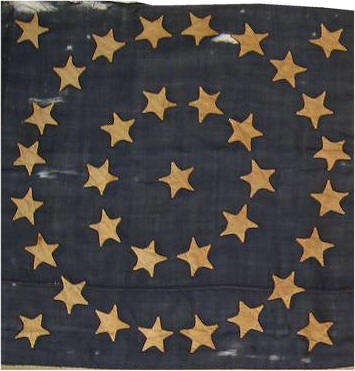 |
Medallion.
Concentric wreaths of stars
are known as the medallion
pattern. This flag of
35 stars from the Civil War
era features two wreaths of
stars surrounding a single
center star, with four
outliers, one in each
corner. It is a
beautiful symmetrical
design. |
 |
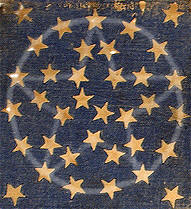 |
Great Star in a Wreath.
Another very rare variation,
found on printed parade
flags of the Civil War era,
is the Great Star in a
Wreath pattern where some of
the stars of an inner Great
Star are shared by a
circular wreath of stars.
The result is a visually
dizzying combination of two
great patterns in flag
collecting: the
Medallion and the Great
Star. This example of
36 stars contains four
outliers and two inliers. |
 |
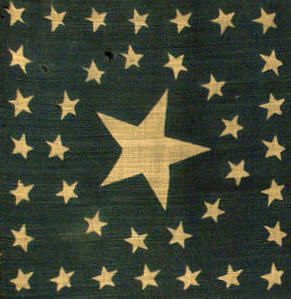 |
Circle in a Square.
The circle in a square
pattern is extremely rare.
The few flags known with
this pattern of stars are
primarily printed parade
flags of the Centennial Era,
though some variations from
the Civil War period are
also known. This
particular example of 38
stars dates to the period of
1876-1890 and is unusual for
its teal blue canton and
press dyed wool
construction. |
 |
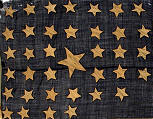 |
Phalanx.
The term "phalanx" dates to
ancient Greece, and
describes a square military
formation of soldiers
intended to protect the
center. Phalanx
pattern flags are very rare.
A handful of phalanx pattern
flags with an open center
are known. On this
flag of thirty-seven stars,
an phalanx with yet to be
filled ranks surrounds a
large center star
representing Nebraska. |
 |
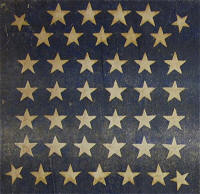 |
Beehive. The
beehive pattern is a rarity
in flag collecting.
This pattern is known on a
handful of printed parade
flags in star counts of 34,
38 and in this shown count
of 42. The resemblance
of the pattern to a beehive
may be coincidental, but
most likely is intentional,
given the industriousness
that bees and a beehive
represent. Even the
smaller skewed corner stars
seem to represent bees
flying outside the hive.
Less than 10 flags in this
pattern are known. |
 |
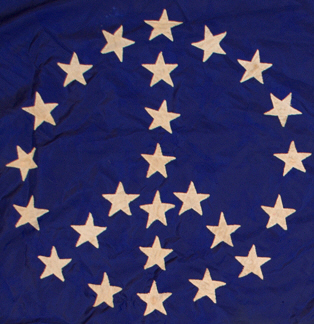 |
Peace Sign.
This flag of began life as a
double-applique 50 star
flag, but in the tumultuous
period of the early 1970s,
at the height of America's
involvement in the Vietnam
War, its stars were removed
and repurposed to produce a
single-sided 25 Star Peace
Flag. The stars are
hand sewn into the
internationally recognized
symbol for peace, designed
in 1958 by British designer
Gerald Holtom. Its shape
derives from a combination
of the semaphore signals for
the letters "N" and "D" in
support of the British
Campaign for Nuclear
Disarmament. Period Peace
Sign flags in the Stars and
Stripes format are scarce
and very symbolic of their
time. |
 |
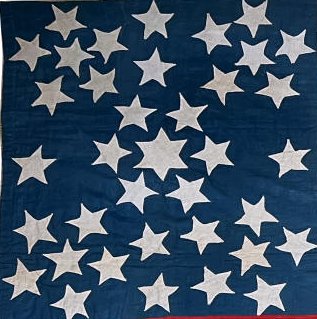 |
The Starry Flower.
The name for this style of
flag, which is exceptionally
rare, was coined by Boleslaw
and Mary-Louise D'Otrange
Mastai in their famous 1973
book on flag collecting.
While some "Great Star"
patterns resemble flowers,
with their arms bowed
outward and resembling
petals, this variation of
the Starry Flower has
clusters of stars in the
corners and in the center.
It is a beautiful and
exuberant pattern,
exceedingly rare with two
similar, but individually
unique, examples known. |
 |
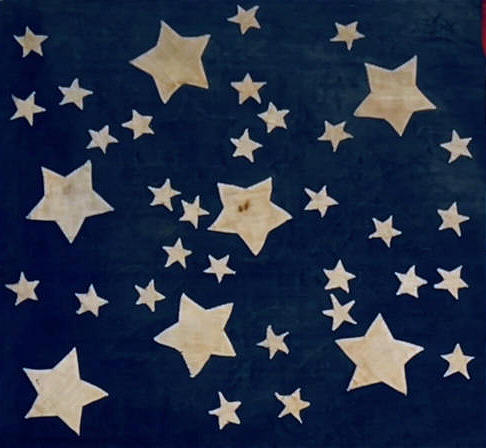 |
The Starry Constellation.
Although the pattern may
seem random, an
exceptionally rare set of
unique flags feature
recognizable "asterisms" or
star constellations on them.
I'm aware of just two early
American flags that feature
constellations or asterisms
on their cantons.
IAS-00400 is an
Abolitionist flag that shows
the bowl of the Big Dipper
and the North Star; and
IAS-00535 shows the
Pleiades on the obverse and
the horns of Taurus the Bull
on the reverse. |
 |

